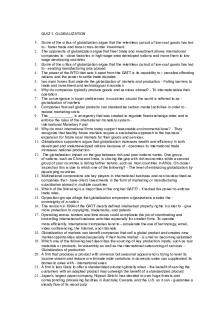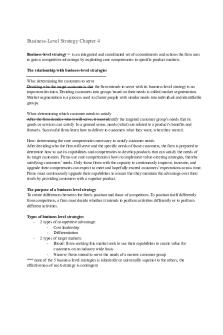Business Combination-Lesson 4 PDF

| Title | Business Combination-Lesson 4 |
|---|---|
| Author | Anonymous User |
| Course | BS Accountancy |
| Institution | Saint Louis University Philippines |
| Pages | 5 |
| File Size | 238.1 KB |
| File Type | |
| Total Downloads | 41 |
| Total Views | 185 |
Summary
SUBJECT: Accounting 15DESCIPTIVE TITLE: Accounting for Business CombinationInstructor: Alfredo R. CabisoThis course covers essential issues on financial accounting and reporting in Business Combinations. It covers accounting on Mergers and Consolidation.The materials in this learning module are from...
Description
SUBJECT: Accounting 15 DESCIPTIVE TITLE: Accounting for Business Combination Instructor: Alfredo R. Cabiso This course covers essential issues on financial accounting and reporting in Business Combinations. It covers accounting on Mergers and Consolidation. The materials in this learning module are from the following: 1. Main reference Textbook: Advanced Financial Accounting: 2021 edition by Antonio Dayag. 2. Other references: Advanced Financial Accounting Volume 2: by Pedro Guerrero & Jose Peralta CPA Reviewer in Practical Accounting 2: by Antonio Dayag CPA Reviewer in Practical Accounting 2: by Pedro Guerrero & Jose Peralta Learning Objectives: The students should be able: To understand the accounting for investment in subsidiaries using the cost model and the equity method To understand the procedures in computing consolidated sales, cost of goods sold, gross profit, in addition to the procedures discussed in the previous lessons. To prepare separate and consolidated financial statement subsequent to date of acquisition Lesson No. 4: Elimination of Unrealized Profit on Intercompany Sales of Inventory Many business transactions between a parent company and its subsidiary involve a profit (gain) or loss. Among these transactions are intercompany sales of merchandise and intercompany sales of plant assets. Since consolidated statements are prepared to show the financial position and the results of operations of two or more affiliated companies as if they were one business company, the unrealized profits or losses in these intercompany transactions must be eliminated in the preparation of consolidated statements, until intercompany profits or losses are realized through the sale of the assets to outsiders. Failure to eliminate unrealized profits and losses would result in consolidated income statements reporting not only the results of transactions with outsiders but also the results of related party transactions within the affiliated group. Similarly, nonrecognition of realized profits and losses would misstate consolidated net income. The management can manipulate the computation of consolidated net income by not eliminating unrealized intercompany profit and losses in the preparation of Consolidated Income Statement. The working paper eliminations involving intercompany profits in inventories are discussed and illustrated in this lesson and those involving intercompany gains in plant assets is covered in the next lesson. The intercompany profit in inventory transfer between affiliates is computed by multiplying the inventory held by the buying affiliate which was acquired from the selling affiliate by the gross profit rate based on sales of the selling affiliate. The working paper elimination entries used in preparing consolidated financial statements must eliminate fully the effects of all transactions between related companies. When there are intercompany inventory transactions, eliminating entries are needed to remove the revenue and expenses related to the intercompany transfers recorded by the individual companies. The elimination ensures that only the historical costs of the inventory to the consolidated entity is included in the consolidated Statement of Financial Position when the inventory is still on hand and is charged to cost of goods sold in the period
Page | 1
the inventory is resold to outsiders. Intercompany sales at Cost
Merchandise sometimes sold to related affiliates at the seller’s cost. When an intercompany sale includes no profit or loss, the inventory amounts at the end of the period require no adjustment for consolidation because purchasing affiliate’s inventory carrying amount is the same as the cost to the selling affiliate and the consolidated entity. Even when the intercompany sale includes no profit or loss, however, an eliminating entry is needed to remove the intercompany sale and the related cost of goods sold recorded by the seller. Page | 2 Intercompany sales at Profit or loss Companies usually markup sale of inventory to affiliates by a certain percentage of cost. The elimination process must remove the effects of such sales from the consolidated statements. When intercompany sales include profits or losses, the working paper eliminations needed for consolidation in the period of sale have two goals: 1. Elimination of the income statement effects of the intercompany sale in the period of sale, removing the sales revenue from the intercompany sale and the related costs of goods sold recorded by the selling affiliate. 2. Elimination from the inventory on the statement of Financial Position of any profit or loss on the intercompany sale that has not been confirmed or realized by resale of the inventory to outsiders. Inventory reported in the consolidated statement of financial position must be reported at cost to the consolidated entity. Effects of Inventory System Used Most companies use either a perpetual or a periodic inventory system to keep track of inventory and cost of good sold. The choice between periodic and perpetual inventory systems results in different entries on the books of the individual companies and, therefore, slightly different working paper eliminating entries in preparing consolidated financial statements. The discussions in this lesson focus on the consolidation procedures used in connection with perpetual inventories. Downstream Sale of Inventory Downstream intercompany sales of merchandise are those from a parent to its subsidiaries. For consolidation purposes, profits recorded on an intercompany inventory sale are realized in the period in which the inventory is resold to outsiders. Until the point of resale, all intercompany profits must be deferred. Consolidated net income must be based on the realized income of the selling affiliate. If the intercompany sales of merchandise are made by the parent company or by a wholly owned subsidiary, there are no effect on any NCI in net income or loss, because the selling affiliate does not have NCI. Upstream sale of Inventory Upstream intercompany sales are those from subsidiaries to the parent company. When an upstream sale of inventory occurs and the inventory is resold by the parent to outsiders during the same period, all the parent entries and the eliminating entries in the consolidated working papers are identical to those in the downstream case. When the inventory is not resold to the outsiders before the end of the period, working paper eliminating entries are different from the downstream case only by the apportionment of the unrealized intercompany to both the controlling and NCI. The intercompany profit in an upstream sale is recognized by the subsidiary and shared between the controlling interest and NCI. Therefor, the elimination of the unrealized intercompany profit must reduce the interests of both ownership groups until the profit is realized by resale of the inventory to outsiders. ACCOUNTING PROCEDURES AND PRO-FORMA COMPUTATION FORMULAS These are, in addition to the procedures used in determining consolidated balances presented in the
consolidated financial statements, the following formulas used are:
Downstream Sales of Inventory(Sales of parent to the subsidiary) Amounts are assumed Selling Price Cost Gross Profit Beg, Inventory P90,000 P72,000 P18,000 Add:Purchases 120,000 90,000 30,000 Available for Sale P210,000 P162,000 P48,000 Less:Ending Inventory 96,000 72,000 24,000 Cost of Sales P114,000 P90,000 P24,000 Upstream Sales of Inventory(Sales of subsidiary to parent) Amounts are assumed Selling Price Cost Beg, Inventory P30,000 P18,000 Add:Purchases 75,000 60,000 Available for Sale P105,000 P78,000 Less:Ending Inventory 30,000 24,000 Cost of Sales P75,000 P54,000
Gross Profit P12,000 15,000 P27,000 6,000 P21,000
Gross Profit Rate 20%% 25% 25%
Gross Profit Rate 40% 20% 20%
Downstream Sales: RGPBI -DS = The Gross profit in beginning inventory represents the realized gross profit which is to be added in the computation of parents Income. UGPEI-DS = The Gross profit in ending inventory represents the unrealized gross profit which is to be deducted in the computation of parent’s income Upstream Sales: RGPBI -US = The Gross profit in beginning inventory represents the realized gross profit which is to be added in the computation of Subsidiary Income. UGPEI-US = The Gross profit in ending inventory represents the unrealized gross profit which is to be deducted in the computation of subsidiary income Notes: a) It is preferable to separate downstream sales from upstream sales b) The use of gross profit rate (GPR) based on sales is preferable. Hence, if the GPR is based on cost, convert it to GPR based on sales Computation of Consolidated Net Income (amounts are assumed) Subsidiary Parent Net income from own operations P100,000 P150,000 Adjustments: RGPBI-DS 18,000 UGPEI-DS (24,000) RGPBI-US 12,000 UGPEI-US (6,000) Amortization (8,000) Adjusted Net income 98,000 144,000 NCI % 20% NCI in net income 19,600 CNI-attributable to parent
Consolidated
242,000- CNI 19,600 -NCI in net income P222,400
The figures for CNI, NCI in net income, and CNI attributable to parents are the same under the full goodwill approach and partial goodwill approach because there is no impairment of goodwill. If there is impairment of goodwill, the figures would differ under partial and full goodwill approach.
Page | 3...
Similar Free PDFs

Business Combination-Lesson 4
- 5 Pages

Business Law - LG 4
- 11 Pages

Business Chapter 4 Notes
- 9 Pages

Unit 4 Family Business
- 21 Pages

Business Ethics - Module 4
- 18 Pages

Business group assingmnent 4
- 16 Pages

CH 4 - Business Level Strategy
- 9 Pages

AB1301 Business Law Bible 4
- 106 Pages

Intro to Business Chapter 4
- 4 Pages
Popular Institutions
- Tinajero National High School - Annex
- Politeknik Caltex Riau
- Yokohama City University
- SGT University
- University of Al-Qadisiyah
- Divine Word College of Vigan
- Techniek College Rotterdam
- Universidade de Santiago
- Universiti Teknologi MARA Cawangan Johor Kampus Pasir Gudang
- Poltekkes Kemenkes Yogyakarta
- Baguio City National High School
- Colegio san marcos
- preparatoria uno
- Centro de Bachillerato Tecnológico Industrial y de Servicios No. 107
- Dalian Maritime University
- Quang Trung Secondary School
- Colegio Tecnológico en Informática
- Corporación Regional de Educación Superior
- Grupo CEDVA
- Dar Al Uloom University
- Centro de Estudios Preuniversitarios de la Universidad Nacional de Ingeniería
- 上智大学
- Aakash International School, Nuna Majara
- San Felipe Neri Catholic School
- Kang Chiao International School - New Taipei City
- Misamis Occidental National High School
- Institución Educativa Escuela Normal Juan Ladrilleros
- Kolehiyo ng Pantukan
- Batanes State College
- Instituto Continental
- Sekolah Menengah Kejuruan Kesehatan Kaltara (Tarakan)
- Colegio de La Inmaculada Concepcion - Cebu

![[Report] International Business - Group 4](https://pdfedu.com/img/crop/172x258/ye5lqyngqzdo.jpg)




